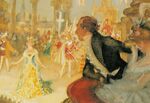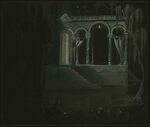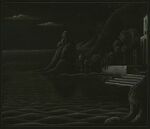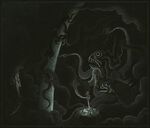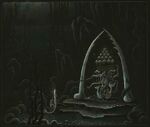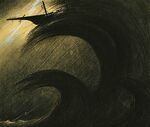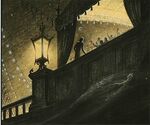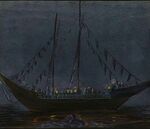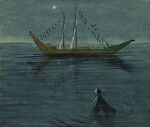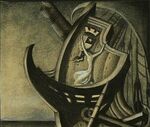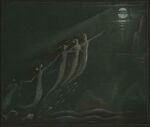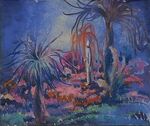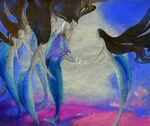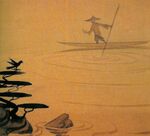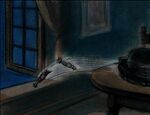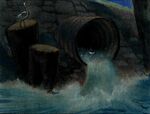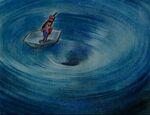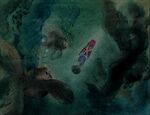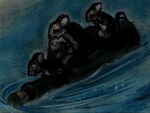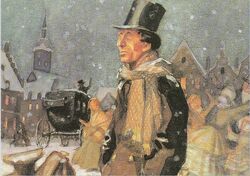
The Life of Hans Christian Andersen was a biography-style film based on the life of the Danish author in question that The Walt Disney Company began developing in the 1940s. The portions depicting Andersen's life were to be shot in live-action, while intertwined segments that depicted his fairy tales were to be animated. At one point, Disney formed a partnership with MGM Studios, asking them to handle the live-action segments, while they worked on the animated ones.
Background[]
Development[]
Plans for a film that would feature a collection of Hans Christian Andersen's fairy-tales were first discussed in late 1937, shortly before the release of Snow White and the Seven Dwarfs. In 1938, the studio was visited by Lady Mabel Dunn, music critic for The London Telegraph, who suggested that Disney could get much material out of Andersen's works. As discussions about the project continued, Actor Jean Hersholt, who had spent a lifetime researching the author was brought in to provide his knowledge. Disney later sent him a sketch from Bambi as thanks.
In December 1939, Disney registered the titles "The Story of Hans Christian Andersen" and "The Tales of Hans Christian Andersen" with the Hays Office. Having previously registered the title "The Life of Hans Christian Andersen" Samuel Goldwyn asked Walt not to use the former title, which he agreed to do. It was not until March 1940 that a partnership between the two studios was considered. However, Disney ultimately disliked the early scripts that MGM sent to them.
- “"The character of Andersen we see as being somewhat similar to that of 'Merton of the Movies'. Merton, a country boy who wanted to crash the movies in the same way that Andersen wanted to crash the theater, was portrayed on stage and screen by Glenn Hunter. He was not only laughable and pitiful, but extremely sympathetic and lovable. This is the way we feel that Andersen should be-a likable, sincere and interesting character throughout".”
- “Al Perkins and Dick Creedon - March 15, 1940”
- ―{{{3}}}
Walt decided to hold off the partnership idea for now but work on the film continued in earnest. In December 1940, Larry Clemmons submitted a screenplay, which he had entitled "The Story Teller". MGM's involvement was reconsidered in 1942 and Samuel Goldwyn and some of their staff were invited to a screening of the initial storyboards in April of that year.
- “"...the 'preview' I had of this one a few weeks ago, sticks in my mind as the most exciting film project I've had a glimpse of in some time. Mr. Goldwyn and I talked about it all the way back from your studio, and he was as het up about as I was. I think it would give you and him great play for respective creative genius and bring great credit on both of you, I sincerely hope you won't drop it."
”
- “Director of Advertising and Publicity William Hebert's letter to Walt Disney - May 1, 1940.”
- ―{{{3}}}
Despite MGM's enthusiasm for the project, Disney became too pre-occupied with war-related films to pursue it any further. In 1952, Samuel Goldwyn co-produced the RKO Radio Pictures musical film Hans Christian Andersen which featured Danny Kaye in the titular role. Disney artists collectively felt that "Walt let Goldwyn get it away from him".
Segments[]
Animated segments based on Andersen's fairy tales that were developed for the film included the following:
- The Little Mermaid - Based on the story of the mermaid who falls in love with a human prince, the artwork for this sequence was designed by Danish illustrator Kay Nielsen who also worked on some of the segments for Fantasia.
- The Little Fir Tree - Adapted from the story about a little tree who wishes to become a Christmas tree and eventually gets his wish. Although, once the holidays are over, the tree is shocked to learn that he gets thrown away. Artwork for this segment was done by Bill Peet, director of The Sword in the Stone.
- Through the Picture Frame - The story of a little boy who goes into a painting to rescue the young princess featured therein, the artwork for this sequence was later used for a 1944 Little Library book of the same name.
- The Emperor's Nightingale - Set in Ancient China, this sequence was to have told the tale of an Emperor who is charmed by the voice of a tiny nightingale, but forgets about it once he is presented with an exquisite, mechanical one.
- The Steadfast Tin Soldier - Adapted from the story of the Tin Soldier and Paper Dancer that fall in love but meet an untimely end in a fireplace, the artwork for this segment was designed by story-woman Bianca Majolie who worked on various shorts throughout the 1930s and '40s, including Fantasia's Nutcracker Suite.



